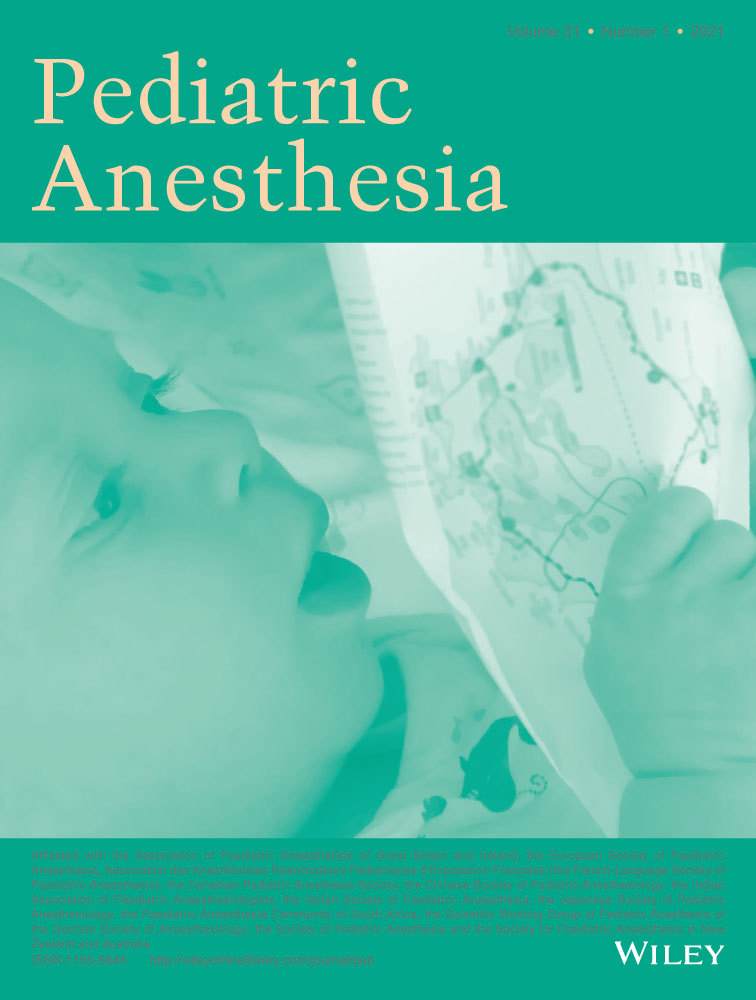Caring for the caregiver following an adverse event
Kenji Tanabe
Department of Anesthesiology, University of Colorado, Aurora, CO, USA
Search for more papers by this authorNorah Janosy
Department of Anesthesiology, University of Colorado, Aurora, CO, USA
Search for more papers by this authorJo Vogeli
Department of Anesthesiology, University of Colorado, Aurora, CO, USA
Search for more papers by this authorAlison Brainard
Department of Anesthesiology, University of Colorado, Aurora, CO, USA
Search for more papers by this authorCorresponding Author
Gina Whitney
Department of Anesthesiology, University of Colorado, Aurora, CO, USA
Division of Pediatric Anesthesiology, Department of Anesthesiology, University of Colorado, Aurora, CO, USA
Correspondence
Gina Whitney, Division of Pediatric Anesthesiology, Department of Anesthesiology, University of Colorado, 13123 East 16th Avenue, Aurora, CO 80045, USA.
Email: [email protected]
Search for more papers by this authorKenji Tanabe
Department of Anesthesiology, University of Colorado, Aurora, CO, USA
Search for more papers by this authorNorah Janosy
Department of Anesthesiology, University of Colorado, Aurora, CO, USA
Search for more papers by this authorJo Vogeli
Department of Anesthesiology, University of Colorado, Aurora, CO, USA
Search for more papers by this authorAlison Brainard
Department of Anesthesiology, University of Colorado, Aurora, CO, USA
Search for more papers by this authorCorresponding Author
Gina Whitney
Department of Anesthesiology, University of Colorado, Aurora, CO, USA
Division of Pediatric Anesthesiology, Department of Anesthesiology, University of Colorado, Aurora, CO, USA
Correspondence
Gina Whitney, Division of Pediatric Anesthesiology, Department of Anesthesiology, University of Colorado, 13123 East 16th Avenue, Aurora, CO 80045, USA.
Email: [email protected]
Search for more papers by this authorAbstract
In this article, we review the potential for adverse impacts on the clinician following a medical error or poor clinical outcome. Second victim syndrome, its symptoms, risk factors, natural history, and possible outcomes are described. We also discuss the important role of organizational leadership and culture and highlight possible programmatic interventions designed to support clinicians following an adverse event.
REFERENCES
- 1Wu A. Medical error: the second victim. West J Med. 2000; 172(6): 358-359. PMID 10854367.
- 2Burlison JD, Scott SD, Browne EK, Thompson SG, Hoffman JM. The_Second_Victim_Experience_and_Support_Tool_.7 copy.pdf. J Patient Saf. 2017; 13(2): 93-102.
- 3 The IHI Triple Aim. Last viewed 08 July 2020. http://www.ihi.org/Engage/Initiatives/TripleAim/Pages/default.aspx
- 4Bondenheimer T, Sinsky C. From the triple to quadruple aim: care of the patient requires care of the provider. Ann Fam Med. 2014; 12(6): 573-576.
- 5Wu AW. Medical error: the second victim. BMJ. 2000; 320(7237): 726-727.
- 6Tumelty ME. The second victim: a contested term? J Patient Safety. 2018; Publish Ahead of Print. https://doi.org/10.1097/PTS.0000000000000558
- 7Harrison R, Lawton R, Perlo J, Gardner P, Armitage G, Shapiro J. Emotion and coping in the aftermath of medical error: a cross-country exploration. J Patient Saf. 2015; 11(1): 28-35.
- 8Waterman AD, Garbutt J, Hazel E, et al. The emotional impact of medical errors on practicing physicians in the United States and Canada. Jt Comm J Qual Patient Saf. 2007; 33(8): 467-476.
- 9Schelbred AB, Nord R. Nurses' experiences of drug administration errors. J Adv Nurs. 2007; 60(3): 317-324. https://doi.org/10.1111/j.1365-2648.2007.04437.x
- 10Horowitz M, Wilner N, Alvarez W. Impact of event scale: a measure of subjective stress. Psychosom Med. 1979; 41(3): 209-218.
- 11Van Gerven E, Bruyneel L, Panella M, Euwema M, Sermeus W, Vanhaecht K. Psychological Impact and recovery after involvement in a patient safety incident. A repeated measures analysis. BMJ Open. 2016; 6:e011403.
- 12Engel KG, Rosenthal M, Sutcliffe KM. Residents’ responses to medical error: coping, learning, and change. Acad Med. 2006; 81(1): 86-93.
- 13Scott SD, Hirschinger LE, Cox KR, McCoig M, Brandt J, Hall LW. The natural history of recovery for the healthcare provider “second victim” after adverse patient events. Qual Saf Health Care. 2009; 18(5): 325-330.
- 14Shanafelt TD, Balch CM, Dyrbye L, et al. Special report: suicidal ideation among American surgeons. Arch Surg. 2011; 146(1): 54-62.
- 15Burlison JD, Quillivan RR, Scott SD, Johnson S, Hoffman JM. The effects of the second victim phenomenon on work-related outcomes: connecting self-reported caregiver distress to turnover intentions and absenteeism. J Patient Saf. 2016; Publish Ahead of Print. https://doi.org/10.1097/PTS.0000000000000301
- 16Chard R. How perioperative nurses define, attribute causes of, and react to intraoperative nursing errors. AORN J. 2010; 91: 132-145.
- 17Muerrier CE, Vincent CA, Parmar DG. Learning from errors in nursing practice. J Adv Nurs. 1997; 26: 111-119.
- 18Hudson DW, Berenholtz SM, Thomas EJ, Sexton JB. A safety culture primer for the critical care clinician: the role of culture in patient safety and quality improvement. Contemp Crit Care. 2009; 7(5): 1-12.
- 19 Organizational Cost of Physician Burnout. https://edhub.ama-assn.org/steps-forward/interactive/16830405. Published September 12, 2018. Accessed June 5, 2020.
- 20Willis D, Yarker J, Lewis R. Lessons for leadership and culture when doctors become second victims: a systematic literature review. Bmj Lead. 2019; 3(3): 81-91.
- 21Brunelli MV, Estrada S, Celano C. Cross-cultural adaptation and psychometric evaluation of a second victim experience and support tool (SVEST). J Patient Saf. 2018; Publish Ahead of Print. https://doi.org/10.1097/PTS.0000000000000497




